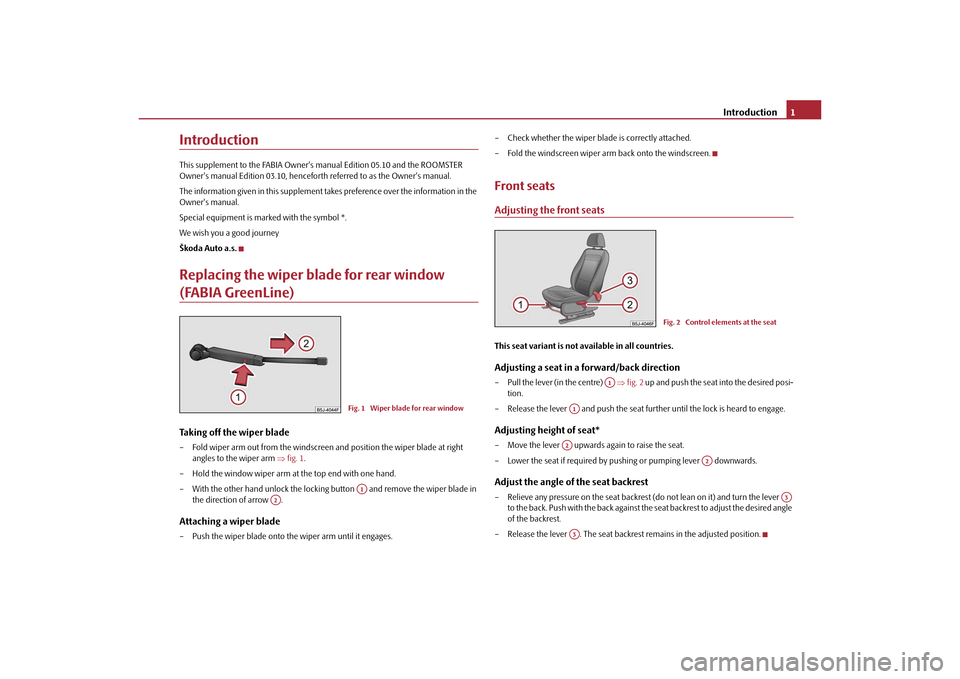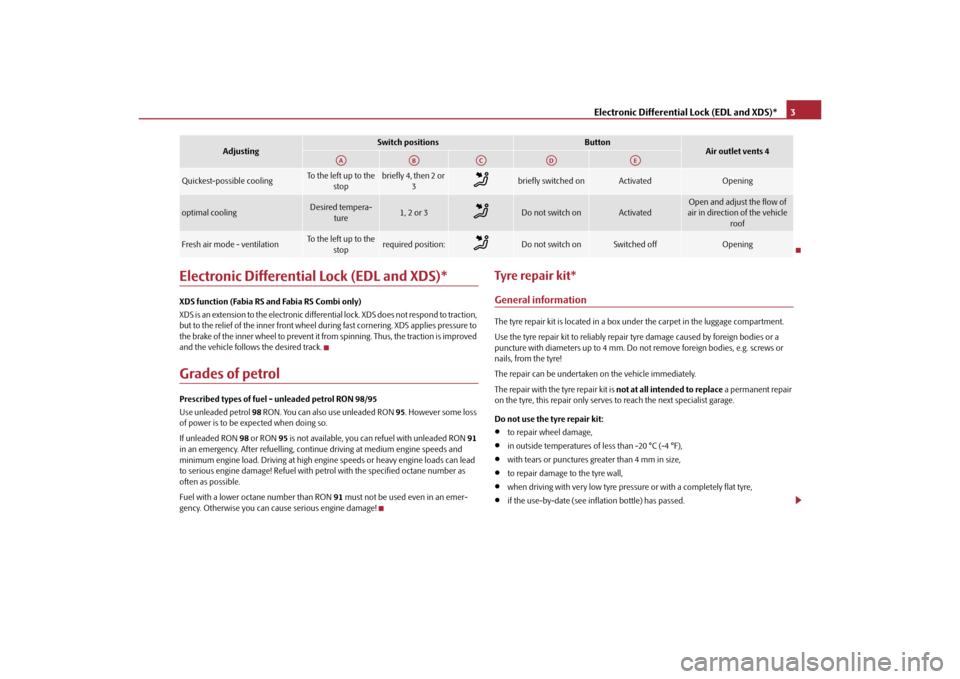lock SKODA ROOMSTER 2010 1.G Technical Change
[x] Cancel search | Manufacturer: SKODA, Model Year: 2010, Model line: ROOMSTER, Model: SKODA ROOMSTER 2010 1.GPages: 14, PDF Size: 0.63 MB
Page 2 of 14

Introduction1
IntroductionThis supplement to the FABIA Owner's manual Edition 05.10 and the ROOMSTER
Owner's manual Edition 03.10, henceforth referred to as the Owner's manual.
The information given in this supplement takes preference over the information in the
Owner's manual.
Special equipment is marked with the symbol *.
We wish you a good journey
Škoda Auto a.s.Replacing the wiper blade for rear window (FABIA GreenLine)Taking off the wiper blade – Fold wiper arm out from the windscreen and position the wiper blade at right angles to the wiper arm fig. 1 .
– Hold the window wiper arm at the top end with one hand.
– With the other hand unlock the locking button and remove the wiper blade in the direction of arrow .Attaching a wiper blade– Push the wiper blade onto th e wiper arm until it engages. – Check whether the wiper blade is correctly attached.
– Fold the windscreen wiper ar
m back onto the windscreen.
Front seatsAdjusting the front seatsThis seat variant is not available in all countries.Adjusting a seat in a forward/back direction– Pull the lever (in the centre) fig. 2 up and push the seat into the desired posi-
tion.
– Release the lever and push the seat further until the lock is heard to engage.Adjusting height of seat*– Move the lever upwards again to raise the seat.
– Lower the seat if required by pushing or pumping lever downwards.Adjust the angle of the seat backrest– Relieve any pressure on the seat backrest (do not lean on it) and turn the lever
to the back. Push with the ba ck against the seat backrest to adjust the desired angle
of the backrest.
– Release the lever . The seat backrest remains in the adjusted position.
Fig. 1 Wiper blade for rear windowA1
A2
Fig. 2 Control elements at the seat
A1
A1A2
A2
A3
A3
s35k.1j.book Page 1 Thursday, September 16, 2010 1:02 PM
Page 4 of 14

Electronic Differential Lock (EDL and XDS)*3
Electronic Differential Lock (EDL and XDS)*XDS function (Fabia RS and Fabia RS Combi only)
XDS is an extension to the electronic differential lock. XDS does not respond to traction,
but to the relief of the inner front wheel during fast cornering. XDS applies pressure to
the brake of the inner wheel to prevent it fr om spinning. Thus, the traction is improved
and the vehicle follows the desired track.Grades of petrolPrescribed types of fuel - unleaded petrol RON 98/95
Use unleaded petrol 98 RON. You can also use unleaded RON 95. However some loss
of power is to be expected when doing so.
If unleaded RON 98 or RON 95 is not available, you ca n refuel with unleaded RON 91
in an emergency. After refuelling, conti nue driving at medium engine speeds and
minimum engine load. Driving at high engine speeds or heavy engine loads can lead
to serious engine damage! Refuel with pe trol with the specified octane number as
often as possible.
Fuel with a lower octane number than RON 91 must not be used even in an emer-
gency. Otherwise you can ca use serious engine damage!
Tyre repair kit*General informationThe tyre repair kit is located in a box un der the carpet in the luggage compartment.
Use the tyre repair kit to re liably repair tyre damage ca used by foreign bodies or a
puncture with diameters up to 4 mm. Do no t remove foreign bodies, e.g. screws or
nails, from the tyre!
The repair can be undertaken on the vehicle immediately.
The repair with the tyre repair kit is not at all intended to replace a permanent repair
on the tyre, this repair only serves to reach the next specialist garage.
Do not use the tyre repair kit:•
to repair wheel damage,
•
in outside temperatures of less than -20 °C (-4 °F),
•
with tears or punctures greater than 4 mm in size,
•
to repair damage to the tyre wall,
•
when driving with very low tyre pressure or with a completely flat tyre,
•
if the use-by-date (see inflation bottle) has passed.
Quickest-possible cooling
To the left up to the
stop
briefly4, then 2or 3
briefly switched on
Activated
Opening
optimal cooling
Desired tempera-ture
1, 2 or 3
Do not switch on
Activated
Open and adjust the flow of
air in direction of the vehicle roof
Fresh air mode - ventilation
To the left up to the
stop
required position:
Do not switch on
Switched off
Opening
Adjusting
Switch positions
Button
Air outlet vents 4
AA
AB
AC
AD
AE
s35k.1j.book Page 3 Thursday, September 16, 2010 1:02 PM
Page 6 of 14

Tyre repair kit*5
– Park the vehicle as far away as possible from the traffic flow. Park on as flat and firm
a surface as possible.
–Have all the occupants get out. While changing a wheel, the occupants of the
vehicle should not stand on the road (e.g. behind a crash barrier).
– Switch off the engine and engage 1st gear or if your vehicle is fitted with an auto-
matic gearbox, position the selector lever into position P .
– Apply the handbrake firmly.
– Check whether you can carry out the repairs with the tyre repair kit page 3,
“General information”.
– If a trailer is coupled, uncouple it.
– Remove the tyre repair kit from the luggage compartment.
– Stick the sticker page 4, fig. 4 on the dash panel in view of the driver.
– Do not remove the foreign body, e.g. screw or nail, from the tyre.
– Unscrew the valve cap.
– Use the valve remover to remove the va lve core and place it down on a clean
surface.Seal and inflate tyresSealing tyres– Forcefully shake the tyre inflator bottle page 4, fig. 4 several times.
– Firmly screw inflation hose onto the tyre inflator bottle in a clockwise direction . The film on the cap is pierced automatically.
– Remove the plug from the inflation hose and plug the open end fully into the tyre valve.
– Hold the bottle with the floor facing up wards and fill the whole sealing agent in
the tyre inflator bottle into the tyres.
– Remove the empty tyre inflator bottle from the valve.
– Screw the valve core back into the tyre valve using the valve remover .
Pumping up the tyres– Screw the tyre inflation hose page 4, fig. 4 of the air compressor firmly onto
the tyre valve.
– Check whether the air re lease valve is closed.
– Start the engine and run it in idle.
– Plug the cable connector into the 12 Vo lt socket in the vehicle, see Owner's
manual.
– Switch on the air compressor with the ON and OFF switch .
– Allow the air compressor to run until reac hing a pressure of 2.0 - 2.5 bars for a
maximum of 8 minutes !
– Switch off the air compressor.
– If you cannot reach an air pressure of 2.0 - 2.5 bar, unscrew the tyre inflation hose from the tyre valve.
– Drive the vehicle 10 metres forwards or backwards to allow the sealing agent to
distribute in the tyre.
– Screw the tyre inflation hose of the air compressor firmly back onto the tyre
valve and repeat the inflation procedure.
– If you cannot reach the required tyre inflation pressure here either, this means the tyre has sustained too much damage. You cannot seal with tyre with the break-
down kit .
– Switch off the air compressor.
– Remove the tyre inflation hose from the tyre valve.
If you reached a tyre inflation pressure of 2.0 - 2.5 bar, resume driving at a maximum
speed of 80 km/h (50 mph).
Check the tyre inflation pressure after driving 10 minutes page 6, “Check after
driving for 10 minutes”.
WARNING
•
During inflation, the tyre inflation hose and air compressor may get hot-
risk of injury!
A2
A1
A10
A3
A10
A3
A10
A1
A5
A7
A9
A8
A5
A5
A5
s35k.1j.book Page 5 Thursday, September 16, 2010 1:02 PM